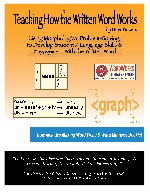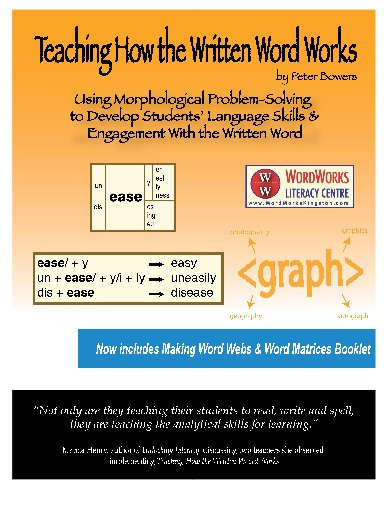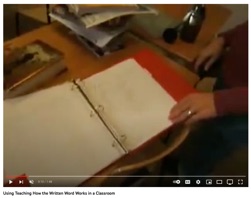Price and ordering information...
Note: Resources purchased in Ontario are subject to Ontario’s 13% HST
How to order:
Place your order simply by eMailing Pete and Sus at <peterbowers1@mac.com>

This book gives background for lessons that walk the teacher/tutor through investigations of the conventions for the three suffixing conventions, working with the matrix and word sum, working with the interrelation between morphology, etymology and phonology. The goal is that teachers can use this book to act as scientists to make sense of the ordered meaning-based structure of English orthography as they teacher their students. Each lesson point to themes from the on-line Real Spelling Tool Box 2 (available by subscription) which expand on the concepts addressed in my book.
Shipping Costs (In CAN):
$10 within CAN
$17 to the US
$30 outside CAN/US
These lessons are based on those in the Gr. 4/5 intervention study (Bowers & Kirby, 2010) that introduced the term “structured word inquiry” to describe the use of scientific inquiry of the written word as a means of literacy instruction.
I encourage teachers of any grade to treat the book as their own personal “textbook” for studying English spelling first. Do the investigations yourself and then choose when and how to bring into your classroom.
Note: Prices for printing and shipping skyrocketed this past year. I waited until new year 2023 to raise my prices to match.
Watch this video to get a quick look inside our WordWorks Teacher Resource Book. While this shows the original Pre-Release version, these lessons are in the new, revised edition also.
Another way to bring this book to life in the classroom!
See this video from years ago Sharon Reichstein, who was introduced to WordWorks in our very first WordWorks Summer Course, talks with Pete about how she integrates ideas from our book, Real Spelling, and her own lessons in her classroom instruction. After you see this, find out more about Sharon’s classroom here.

Our Teacher Resource Book
Teaching How the Written Word Works offers an introduction to the core concepts of how the ordered way English spelling works. It uses a series of lessons designed to help teachers, tutors and parents make sense of English spelling along with their young co-learners. The lessons focus on morphological analysis with the matrix and word sum.
Research Tested
These tools are central not only to understanding how morphological families of words are structured, but also how morphology interrelate.
The main series of lessons in this book were the lessons I used in my Grade 4/5 intervention (Bowers & Kirby, 2010) that showed generative vocabulary learning.

-
 Guidance morphological problem-solving so that you can use these lessons as a jumping off point to investigate any words that grab your interest or that of your students;
Guidance morphological problem-solving so that you can use these lessons as a jumping off point to investigate any words that grab your interest or that of your students; -
 Links to other on-line resources;
Links to other on-line resources; -
 Links to related Real Spelling resources.
Links to related Real Spelling resources.
When students and teachers work with word sums and morphological matrices for a little while, these are the kinds of questions that grab the attention of a class.
Integrating morphological analysis into shared and guided reading lessons
As well as explicit lessons taking teachers through “teacher-led inquiries” of words, this books models ways teachers can integrate word structure instruction into reading and writing in any content area by using morphological problem-solving as a tool for shared and guided reading.
By practicing spelling investigations with lessons in the book, you will be prepared when students ask you spelling questions that you are not able to explain right away. You will have practices the process of investigaging spelling, so now you can move into “inquiry-led teaching” by applying the problem solving skills you learn through these lessons.

See ths message from a tutor new to SWI usng this book:
Hi Pete, I'm absolutely LOVING your book - Teaching How the Written Word Works! I've taught two of my more challenging clients how to be 'word scientists' and they've gotten soooo excited (after 1 session!). I could actually see the light bulbs turn on :D My younger client actually jumped out of his chair he was so excited-it was amazing!
Today was the second session with my younger client and we started making hypotheses from our observations...He's excited to hear back from you... Btw, he's a pretty precocious 4th grader who's been really tired of learning how to spell, so you've completely changed his mind after 2 sessions!
